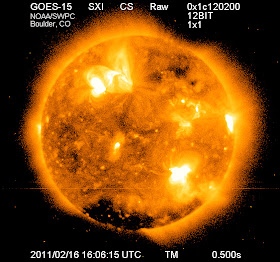Economies around the world have become increasingly vulnerable to the ever-changing nature of the sun. Solar flares can disrupt power grids, interfere with high-frequency airline and military communications, disrupt Global Positioning System (GPS) signals, interrupt civilian communications, and blanket the Earth’s upper atmosphere with hazardous radiation.
Monitoring and forecasting solar outbursts in time to reduce their effect on space-based technologies have become new national priorities. And NOAA’s Space Weather Prediction Center (SWPC), part of NOAA’s National Weather Service, is the nation’s official source of space weather forecasts, alerts, and warnings.
“The Space Weather Prediction Center is critical to our economy because each time we use a cell phone or pager, check a GPS locator, turn on a light, or take an over-the-pole flight, space weather could have an effect,” said Jack Hayes, Ph.D., director of NOAA’s National Weather Service.
Looking Toward the Sun
To monitor events on the sun, SWPC staff utilize a variety of ground- and space-based sensors and imaging systems to view activity at various depths in the solar atmosphere.
 | Use of Data and Products: The information on government servers are in the public domain, unless specifically annotated otherwise, and may be used freely by the public so long as you do not 1) claim it is your own (e.g. by claiming copyright for NWS information), 2) use it in a manner that implies an endorsement or affiliation with NOAA/NWS, or 3) modify it in content and then present it as official government material. You also cannot present information of your own in a way that makes it appear to be official government information. |
| As required by 17 U.S.C. 403, third parties producing copyrighted works consisting predominantly of the material appearing in NWS Web pages must provide notice with such work(s) identifying the NWS material incorporated and stating that such material is not subject to copyright protection. This file is a work of a employee of the NOAA/NWS, taken or made during the course of the person's official duties. As a work of the U.S. federal government, the file is in the public domain. Generally speaking, works created by U.S. Government employees are not eligible for copyright protection in the United States. See Circular 1 "COPYRIGHT BASICS" PDF from the U.S. Copyright Office. | |
A worldwide network of USAF-sponsored optical observatories also provides space weather forecasters with detailed, plain-language information about activity in and around sunspot groups, as well as other areas of interest on the sun.
Space weather forecasters also analyze the 27-day recurrent pattern of solar activity. Based on a thorough analysis of current conditions, comparing these conditions to past situations, and using numerical models similar to weather models, forecasters are able to predict space weather on times scales of hours to weeks.
With effective alerts and warnings, we can minimize the hazards to technology. For example, satellite operations can be adjusted, power grids can be modified, and polar flights can be rerouted.
A Brighter Future
Scientists and forecasters work closely with government and university partners to develop prediction models and other tools to improve services to the nation’s space weather community. SWPC also helps move the latest computer models of solar dynamics and sun-Earth interactions into the daily operations of space weather prediction.
NOAA and partner agencies in the National Space Weather Program are leading the way in this new era of space weather awareness to provide timely, accurate information and forecasts to help keep our advanced-technology global economy moving forward.
No comments:
Post a Comment